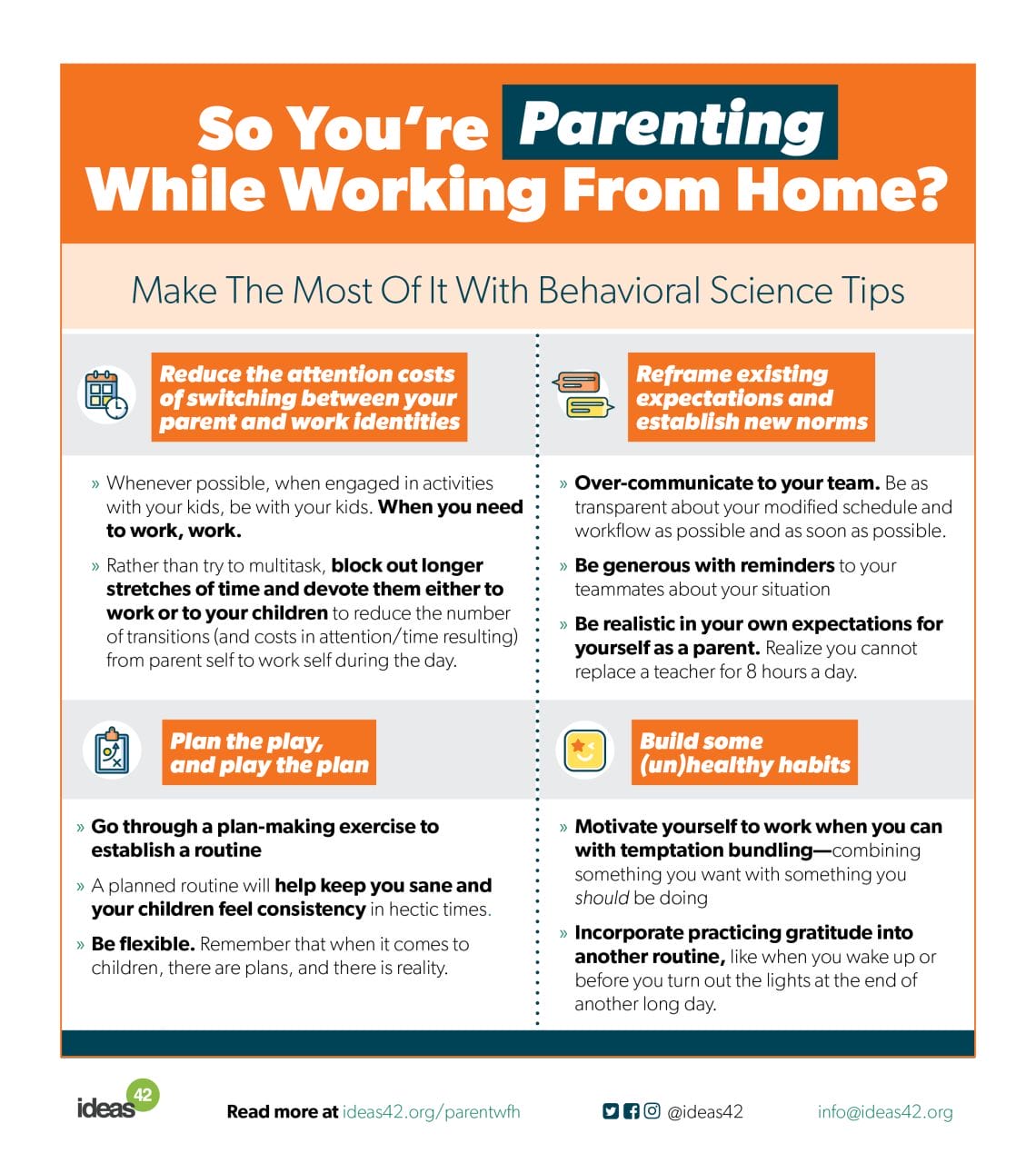This is part of a series of posts about behavioral science and COVID-19. Click here to read about some of the most important behaviors during this pandemic—like healthy distancing and seeking medical help, and responding to humanitarian crises in a global outbreak.
Greetings from the Wild West of parenting while working from home. How are you? No, really, how are you?
We at ideas42 are working hard to produce actionable guides to help problem-solvers, as well as individuals, during the global COVID-19 pandemic. These posts explore important topics like: how to protect yourself and others with healthy distancing, what to do if you’re sick, critical financial relief, improving online learning, and humanitarian responses to this crisis. In this post, we’ll explore something that pales in comparison to the very real struggles of many who are impacted by this pandemic and the resulting economic fallout, as well as those serving on the frontlines, but nevertheless is weighing heavily on many parents who find themselves both working from home and raising their – ahem– beloved children.
On this topic, we find that beyond applying what we know from behavioral science, it helps to use a little levity—a break from the seriousness that is COVID-19.
Before we get to the good stuff, I humbly submit to the reader a review of the last 2 hours of my “work day”:
- Deciding whether or not to change my breastmilk-stained shirt before my 1pm Zoom meeting. Maybe it’s a good time for that airbrush feature?
- Having a deep conversation in the bathroom about trucks with my 3-year old who doesn’t respect privacy quite yet. No, nothing is sacred in this house anymore.
- Noticing my firstborn, my dog (I Forgot Her Name Again Oh Yes It’s Fenway), stare at me longingly for a walk
- Reviewing a final deliverable for an important, time-sensitive project in our Economic Justice portfolio
Is it really only Wednesday?
Maybe some of you have had similar experiences while working, and are also on your fifth breakdown. Maybe some of you have it all figured out. If you’re the latter, go ahead and stop reading now and just keep it to yourself.
If you’re the former, welcome to the club. Unfortunately, unless a COVID19-resistant Mary Poppins falls from the sky and decides to shelter in place with the family, it’s likely this is going to be reality for a bit.
Here’s the good news. There isn’t a book on parenting in a pandemic (we’re waiting, Emily Oster…) but there are some things I’ve learned from my experience both working in applied behavioral science and as a parent of two young children that might help.
As with all things parenting-related, you can apply what you want and leave what won’t work for you. Another critical disclaimer: This is of course most helpful for people who have the privilege of a more flexible environment and/or work situation, which is something I am extremely grateful for right now, as of course there are many who do not.
1) Mitigate the attentional switching costs between your identities of parent and employee
Being a working parent is hard. And taxing. But in this pandemic reality we find ourselves in, already-taxed attention is even more taxed by things like:
- Making sure you have toilet paper (seriously, don’t panic buy)
- Completing work for your ‘day’ job
- Feeding and cleaning your children and occasionally even yourself
- The ambiguity of the economic fallout and future
- Addressing the elephant in the room: staying safe, appropriately isolated, and healthy during a PANDEMIC
Let’s face it, work life and parent life are colliding. And constantly switching between your Parent Identity to put on your Work Identity throughout the day is incredibly difficult and only increases the cognitive bandwidth tax. Truly, it’s a lot, and actually, it’s also impossible. You simply can’t expect your weekend parenting self to report for duty when your workday self needs to be present as well. There’s no way you’ll replace your child’s teacher, or do 8 hours of homeschool and 8 hours of work in a day. Full stop.
Here’s a heuristic I’ve found helpful:
- Whenever possible, when engaged in activities with your kids, be with your kids. When you need to work, work.
- Rather than try to multitask, block out longer stretches of time and devote them either to work or to your children to reduce the transitions from parent self to work self during the day.
- For me, 9am-1pm is for parenting, and then 1pm to 5pm and later is for work (which is during both nap time and when my husband can tap in). This gives me longer windows of focus without the distractions and switching costs that are so draining on my productivity as both a parent and professional.
2) Reframe the existing expectations and establish new norms.
You need to make adjustments at work to account for your new double life. That internal project you’ve been championing on the side to improve something at your organization? Shelve it. That non-essential meeting? Maybe it really can just be an email.
Now is not the time for going above and beyond, now is the time for preserving your sanity. Yes, YOUR SANITY. However, to do this well, you need to communicate with your teams.
- What work can you do? When can you do it?
- You cannot be as attentive of an employee as you were, so be as transparent about that as much as possible and as soon as possible.
- Since it’s a hectic time for everyone, be generous with reminders to your teammates about your situation.
- If you have a shared calendar, block out time to help remind them when you’re working and when you’re parenting, if you can.
Guess what? Chances are there are others at your organization who are feeling torn between two worlds too and by being open and honest about it, you’ll be contributing to a new, visible norm that allows all team members who are also parents to get by a little bit easier.
Bonus suggestion: Have a virtual happy hour with your fellow parent team members and vent about your new office mates, the ones who are immune to reason.
3) Plan the play, and play with the plan.
Those who have young children like me might know this Sesame Street song (you’re welcome). Plan-making is a common tool in the behavioral designer’s toolbox, and in this context it can help sort out the pieces that result from this new work-life collision.
Do you know that parent with the irritatingly perfect, color-coordinated schedule? I’m sorry to say, but she’s actually onto something. Some form of a planned routine will help keep you sane and your children feel consistency in hectic times. When this all began, my husband and I mapped our family’s schedules to see what made the most sense for us as far as when I could reasonably expect to work. Going through this exercise may help to formulate a plan with a partner (if you are even luckier than most and have one that’s available) for when you each have that glorious uninterrupted work time or when it’s your turn for “parent duty.”
So now, between 9am-1pm I’m largely focused on my kids and being present with them. We do fun and educational activities. We get fresh air while maintaining a healthy physical distance from others. I carry my phone with me for urgent needs, but I largely leave it unchecked.
Remember that when it comes to children, there are plans, and there is reality.
If you need to work during kid time, try to find something for them to do independently. For my toddler, that’s either FaceTiming with isolated grandparents who can read to him, or in a pinch, having him watch his favorite video for the 100th time. Whatever works.
Your children might indulge in more YouTube videos than you’d ever imagined. And that’s ok. What’s most important right now is ensuring your children’s health and emotional well-being, not worrying about adhering to the American Academy of Pediatrics recommended screen time allowance.
When a baby makes an appearance on a conference call or your toddler feels compelled to showcase his battery-operated garbage truck toy on Zoom, just shrug it off. These are the new norms of our time, and we need to be generous with each other as teammates.
And when you can, please also schedule some time for self-care, even just a couple of minutes. You need your oxygen first in order to be able to care for others.
4) Build some (un)healthy habits.
Chances are at some point you’re going to find yourself working odd hours when your kids are sleeping or on a weekend. Our work-life conflict team wouldn’t be pleased with me (and I can feel Adam Grant cringing out there in the world), but sometimes, you have to do what you have to do. If you’re having trouble with motivation during odd work blocks, you can try temptation bundling.
- Simply take the thing that you “should” do and combine it with something you really want. For instance, I’m only allowed to break into my stash of chocolate when I work at night after the kids go to bed. Or, I can only use a hydrating face mask while working. Early riser? Try saving your nicer cup of coffee or tea leaves for a work block.
- This is usually applied in the service of building habits, but as parents working with kids at home, we’re just getting through the days here.
And speaking of healthy habits we should actually be building, try to practice some gratitude.
- Find two to three things that you’re grateful for right now. Yes, right now.
- Write them in a Word document or on a physical pad of paper.
- Whatever it is, find 2 minutes to actively write it down. Maybe it’s that you have a job that allows you to work from home and provides financial stability. Maybe it’s your stash of Netflix and microwave popcorn.
- Pro tip: you don’t need paragraphs (who has time for that right now?!) but rather a sentence or phrase or even a word or picture.
- Now, repeat that. Everyday.
Incorporate the practice of gratitude into another routine, like when you wake up or before you turn out the lights at the end of another long day. It will instantly make you feel better, and may have longer-term benefits for stress reduction and overall happiness.
Looking for inspiration? Here’s my gratitude list from today:
- My healthy children whom I love so much
- My remote job applying behavioral insights to Economic Justice, which gives me flexibility and stability
- All of the doctors, nurses, and other healthcare workers making tremendous sacrifices in impossible circumstances to care for those affected by COVID-19
On that note, with the growing cry of a child in the distance, I hope that in reading this piece, you had a few laughs, and maybe found something that helps you “survive” this time at home.
Stay tuned for more blog posts from ideas42 about the COVID-19 pandemic.
For up-to-date public health information, please visit the CDC’s information center.




